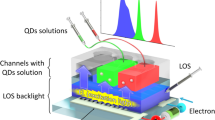Abstract
Conventional electrowetting displays reconfigure the contact angle of a coloured oil film on a planar hydrophobic surface. We report on electrofluidic displays, in particular a three-dimensional microfluidic display device that provides a direct view of brilliantly coloured pigment dispersions. Electromechanical pressure is used to pull the aqueous dispersion from a reservoir of small viewable area (<10%) into a surface channel of large viewable area (>90%). The hydrophobic channel and reservoir respectively impart a small or large radius of curvature on the dispersion. Therefore, with no voltage, Young–Laplace pressure forces the dispersion to retract into the reservoir. Preliminary prototypes exhibit ∼55% white reflectance, and future development points towards a reflectance of ∼85%. Uniquely, compared to electrowetting pixels, the electrofluidic pixels reduce the visible area of the coloured fluid by an additional two to three times (improving contrast), are potentially bistable, are as thin as ∼15 µm (giving potential for rollable displays), and can be miniaturized without increased operating voltage.
This is a preview of subscription content, access via your institution
Access options
Subscribe to this journal
Receive 12 print issues and online access
$209.00 per year
only $17.42 per issue
Buy this article
- Purchase on Springer Link
- Instant access to full article PDF
Prices may be subject to local taxes which are calculated during checkout





Similar content being viewed by others
References
Huitema, H. E. A. et al. Flexible electronic-paper active-matrix displays. J. Soc. Inf. Display 14, 729–733 (2006).
Hayes, R. A. & Feenstra, B. J. Video-speed electronic paper based on electrowetting. Nature 425, 383–385 (2003).
Khan, A. et al. Reflective cholesteric LCDs for electronic paper applications. Proc. International Display Manufacturing Conference 397–399 (2005).
Back, U. et al. Nanomaterials-based electrochromics for paper-quality display. Adv. Mater. 14, 845–848 (2002).
Nakashima, M. et al. Naturally white electrochromic display using organic/inorganic nanocomposite pulp. SID Symp. Dig. 36, 1678–1681(2005).
Miles, M. et al. Digital paper for reflective displays. J. Soc. Inf. Display 11, 209–215 (2003).
Hattori, R. et al. A novel bistable reflective display using quick-response liquid powder. J. Soc. Inf. Display 12, 75–80 (2004).
Mugele, F. & Baret, J. Electrowetting: from basics to applications. J. Phys. Condens. Matter 17, R705–R774 (2005).
Berthier, J. Microdrops and Digital Microfluidics (William and Andrew, 2008).
Fair, R. Digital microfluidics: is a true lab-on-a-chip possible? Microfluidics Nanofluidics 3, 245–281 (2007).
Jones, T. B. An electromechanical interpretation of electrowetting. J. Micromech. Microeng. 15, 1184–1187 (2005).
Hanlon, R. T. & Messenger, J. B. Cephalopod Behaviour (Cambridge Univ. Press, 1998).
Kramer, R. M., Crookes-Goodson, W. J. & Naik, R. R. The self-organizing properties of squid reflectin protein. Nature Mater. 6, 533–538 (2007).
Verheijen, H. & Prins, M. Reversible electrowetting and trapping of charge: model and experiments. Langmuir 15, 6616–6620 (1999).
Sun, B. et al. Scalable fabrication of electrowetting displays with self-assembled oil dosing. Appl. Phys. Lett. 91, 011106 (2007).
Mugele, F. & Buehrle, J. Equilibrium drop surface profiles in electric fields. J. Phys. Condens. Matter 19, 375112 (2007).
Song, J., Evans, R., Lin, Y. Y., Hsu, B. N. & Fair, R. A scaling model for electrowetting-on-dielectric microfluidic actuators. Microfluidics Nanofluidics http://dx.doi.org/10.1007/s10404-008-0360-y (2009).
Cristea, D. & Vilarem, G. Improving light fastness of natural dyes on cotton yarn. Dyes and Pigments 70, 238–245 (2006).
Roques-Carmes, T. et al. The effect of the oil/water interfacial tension on electrowetting driven fluid motion. Colloids Surf. A 267, 56–63 (2005).
Brown Elliot, C., Credelle, T. & Higgins, M. Adding a white subpixel. Inf. Display 5, 26–31 (2005).
Shiyanovskaya, I. et al. Single substrate coatable multicolor cholesteric liquid crystal displays. Proc. Soc. Inf. Display 38, 65–68 (2007).
Blankenbach, K. et al. Novel highly reflective and bistable electrowetting displays. J. Soc. Inf. Display 16, 237–244 (2008).
Jang, S. et al. Tight bonding of two plastic substrates for flexible LCDs. Proc. Soc. Inf. Display 38, 653–656 (2007).
Acknowledgements
The authors acknowledge partial financial support for Cincinnati's general program in displays by Sun Chemical Corp., Motorola (K. Dean), Polymer Vision (E. Huitema), ITRI Taiwan (W. Cheng), Air Force Research Labs (R. Naik), Air Force Office of Scientific Research (AFOSR) Young Investigator Award no. 06NE223 (K. Reinhardt), and an National Science Foundation (NSF) CAREER Award no. 0640964 (Electronics Photonics & Device Technologies (EPDT)). The authors thank R. Fair of Duke University for discussion on switching speed in microscale electrowetting cavities.
Author information
Authors and Affiliations
Corresponding author
Ethics declarations
Competing interests
Both Sun Chemical and PolymerVision are corporate sponsors of this work and have commercial interest in the outcome of the research performed at the University of Cincinnati.
Rights and permissions
About this article
Cite this article
Heikenfeld, J., Zhou, K., Kreit, E. et al. Electrofluidic displays using Young–Laplace transposition of brilliant pigment dispersions. Nature Photon 3, 292–296 (2009). https://doi.org/10.1038/nphoton.2009.68
Received:
Accepted:
Published:
Issue Date:
DOI: https://doi.org/10.1038/nphoton.2009.68
This article is cited by
-
Programmable microfluidics for dynamic multiband camouflage
Microsystems & Nanoengineering (2023)
-
Open-channel microfluidics via resonant wireless power transfer
Nature Communications (2022)
-
Merging metasurfaces with microfluidics
Nature Nanotechnology (2022)
-
Metasurface optofluidics for dynamic control of light fields
Nature Nanotechnology (2022)
-
Observation of contact angle hysteresis due to inhomogeneous electric fields
Communications Physics (2021)



